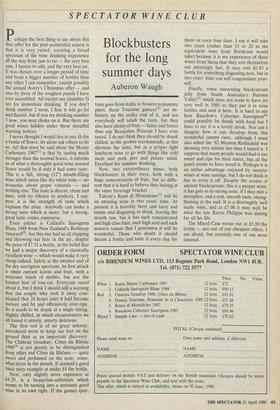SPECTATOR WINE CLUB
Blockbusters for the long summer days
Auberon Waugh
erhaps the best thing to say about this first offer for the post-penitential season is that it is very varied, covering a broad spectrum of the wine drinking experience all the way from jam to tar — the very best jam, I hasten to add, and the very best tar. It was chosen over a longer period of time and from a bigger number of bottles than any other I can remember, except possibly the annual Avery's Christmas offer — and also by three of the toughest panels I have ever assembled. All except one (number 5) are for immediate drinking. If you don't drink number 2 soon, I fear it will go fat and flaccid, but if you try drinking number 5 now, you may choke on it. But there are good wines hidden under these dreadful warning notices.
I never thought I would live to pay £6 for a bottle of Soave, let alone ask others to do so. All that must be said about the Monte Carbonate 1987(1) is that by tasting much stronger than the normal Soave, it informs us of what a thoroughly good wine normal Soave would be if only it had some taste. This is a full, strong (12°) mouth-filling wine which tastes like dry white wine — no nonsense about grape varietals — and nothing else. The taste is decent, clean and pure, with no offence to modesty. I sup- pose it is the strength of taste which explains the price. Anybody can make a strong taste which is nasty, but a strong, good taste comes expensive.
Even pricier is Collard's Sauvignon Blanc 1989 from New Zealand's Rothesay vineyard(2), but this one had us all clapping and throwing our hats in the air, despite the price of £7.51 a bottle, in the belief that we had a major discovery of a classically excellent wine — which would make it very cheap indeed. Safely at the sweeter end of the dry sauvignon spectrum, its first attack is white currant leaves and fruit, with a welcome touch of nettles, but not the faintest hint of tom-cat. Everyone raved about it, but I think I should add a warning that the couple who took it away com- plained that 24 hours later it had become melony and fat and offensively over-ripe. So it needs to be drunk at a single sitting, slightly chilled, in which circumstances we all found it utterly, utterly delicious.
The first red is of no great interest, introduced more to keep our feet on the ground than as an important discovery. The Chateau Goudray, Cotes du RhOne 1988(31 is not greatly to be distinguished from other red Cotes du Rh6nes — quite sweet and perfumed on the nose, some- what dryer in the mouth. It seemed a good basic tasty example at under £4 the bottle.
Next, only slightly more expensive at £4.29, is a beaujolais-substitute which seems to be turning into a seriously good wine in its own right. If the gamay spec- trum goes from stalks to flowers to plummy pinot, these Touraine gamays(4) are de- finitely on the stalky end of it, and not everybody will relish the taste, but they also have plenty of fruit — fuller and better than any Beaujolais Primeur I have ever tasted. I do not think they should be drunk chilled, as the grower recommends, as this shortens the taste, but as a proper light luncheon wine to go with things like cold meat and pork pies and potato salad. Excellent for summer drinking.
Now, two extraordinary wines, both blockbusters in their ways, both with a huge concentration of fruit, but so diffe- rent that it is hard to believe they belong in the same beverage bracket. Talenti's Rossi di Montalcino(5) will be an amazing wine in two years' time. At present it is horribly furry and tarry and tannic and disgusting to drink, leaving the mouth raw, but it has such concentrated and high class fruit, such high acid and such massive tannin that I guarantee it will be wonderful. Those who doubt it should decant a bottle and taste it every day for three or even four days. I say it will take two years (rather than 15 or 20 as the equivalent wine from Bordeaux would take) because it is my experience of these wines from Siena that they sort themselves out amazingly fast. It may cost £6.83 a bottle for something disgusting now, but in two years' time you will congratulate your- self.
Finally, some interesting blackcurrant jelly from South Australia's Barossa Valley(6) which does not seem to have set very well in 1985 so they put it in wine bottles and sent it here. It is hard to see how Basedow's Cabernet Sauvignon(6) could possibly be drunk with food but I have to say it is a lovely drink. Nor can I imagine how it can develop from this wonderful jammy taste, although I must also admit the '82 Mouton Rothschild was showing very similar last time I tasted it. I suppose that many people would find it too sweet and ripe for their tastes, but all the panel seems to have loved it. Perhaps it is an unfair advantage enjoyed by sweeter wines at wine tastings, but I do not think it fair to write it off. Despite the aroma of ancient blackcurrant, this is a proper wine; it has guts in its strong nose, if I may mix a metaphor, and a rich, smooth taste, streng- thening at the end. It is a thoroughly well made wine, and at £7.08 it may well be what the late Baron Philippe was aiming for all his life.
The Mixed Case works out at £5.89 the bottle — not one of our cheapest offers, I am afraid, but certainly one of our most unusual.


















































 Previous page
Previous page